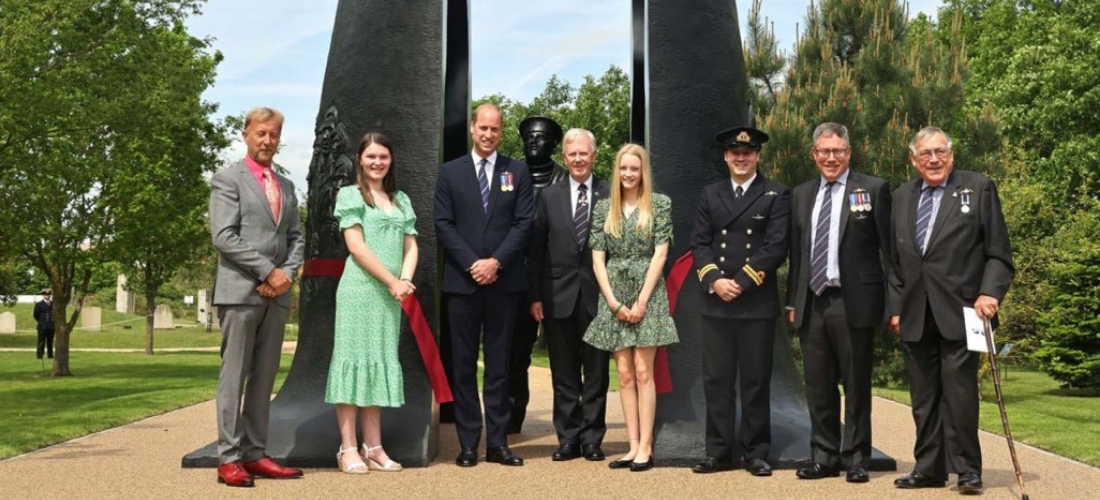Last week, Wednesday 18 May 2022, saw the unveiling of the new Submariner Memorial at the National Memorial Arboretum. The Memorial was unveiled by HRH Duke of Cambridge, and designed by Chris Groves and his family after winning a national competition.
Chris, a recently retired Royal Navy submariner, is now the Underwater Business Development Lead for QinetiQ. His father, Adrian, is also a retired submariner and his son, Nick, and Nick’s girlfriend Emma are both currently serving submariners. They were joined by another submariner’s son, Si Ellis, who is a design consultant, and together the team came up with the design which was translated into the final memorial by British sculptor Paul Day.
Chris, on behalf of the Groves Family, said: “Three generations of our family have been submariners. We are really passionate about the Submarine Service and we wanted to create a design that would fittingly be a memorial for all the submarine family. We wanted the design to be unique to the service, to acknowledge submariners sacrifice and that of all those they leave behind, families and friends, and to show the environment that submariners operate in.”
The Memorial was funded by the Submariner Memorial Appeal, supported by the Royal Navy and Royal Marines Charity (RNRMC), and replaced a small plaque.
Chairman of the appeal, Vice Admiral Peter John Wilkinson CB CVO said: “There is no more challenging environment in which to work – the great oceans of the world are tough enough, but to operate safely and effectively, deep under their surface demands great skill and dedication; And for many, we must also acknowledge the enduring pain caused by the memory of lost shipmates, who made the ultimate sacrifice on our behalf. I know that this memorial, this arboretum, means something to every one of us.”
Actor Colin Firth also supported the appeal after starring in Kursk: The Last Mission about the loss of a Russian submarine, and playing Ewen Montagu in Operation Mincemeat. He said: "Filming Kursk: The Last Mission gave me a vivid insight into the lives of our submariners. The service and their loved ones have made huge sacrifices over the past century - and continue to do so today as they carry out their secret work far from public gaze. As so many of our lost submariners have no graves, a fitting memorial at the National Arboretum will give those left behind a place to gather and grieve.”
Chris added: “It was a real honour to have been at the Dedication Ceremony. We were bursting with pride to be stood alongside Prince William for the ‘ribbon cutting’ and to meet him beforehand to explain our design. To have my dad, Adrian, and son, Nick, alongside me was truly special. We have over 85 years of Submarine Service between the members of the Groves Family team so it was really phenomenal to have our design selected and to play our part in this incredible memorial to the sacrifice of past and present members of the Submarine Family.
“We are delighted with the final result, which is a really iconic statement amongst the many other memorials at the Arboretum. We are hugely proud.”
The memorial is 4m long and 3.5m high, cast in Bronze, with a quote by Sir Winston Churchill: “Of all the branches of men in the forces there is none which shows more devotion and faces grimmer perils than the submariner.”
Sculptor Paul Day said: “I’m delighted that the winning design was created by submariners. It resonated with me instantly. By mirroring that design, I imagined visitors walking through a somewhat confined space - suggesting those constraints upon movement that dictate life on-board. In the centre, the lone submariner gazes upwards.
“I decided to sculpt vertical wave forms within the interior of my design, not only to evoke that obvious, primary element in which submarines exist: that of seawater; but also to echo the other, less obvious wave - also critical to the operational life of the submarine - sound waves. This is the so-called "Silent Service”. Thus, detection or avoiding detection - and consequently that necessary element of surprise - are determined by how silently the craft can move through water.”
Chris still supports the work of submariners through his work at QinetiQ, which delivers test and evaluation solutions to ensure mission critical capability and operational advantage required by governments, navies, shipbuilders, OEMs, regulators and ship owners to understand, confront and overcome new challenges. This includes hydromechanics, testing of marine structures, materials and survivability (including shock qualification), acoustic, electromagnetic and other signatures in-service ranging and electromagnetic and magnetic open sea ranging. The acoustic work ensures that the Royal Navy’s submarine fleet can continue to remain the ‘silent service’ keeping the waters of the UK safe and secure.
The Submarine Service
Often known as the ‘Silent Service’ the Royal Navy has always been at the forefront of underwater warfare and has built an enduring reputation for professionalism and courage. Submarines combine qualities of stealth, endurance and flexibility, characteristics which give them unparalleled freedom to operate worldwide in support of national and coalition operations. Since 1968, the Royal Navy has upheld a patrol mission of Continuous At Sea Deterrence. As the current Vanguard-class submarines reach the end of their lifecycle, they will be replaced by a fearsome new breed of nuclear submarine: the Dreadnought class. For more information on Submarines, visit the Royal Navy website here.
